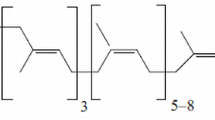Abstract
Statistically significant antigenotoxic activity was exerted by six of nine strains of lactic acid bacteria tested (Lactobacillus delbrueckii subsp. bulgaricus, Staphylococcus carnosus, Streptococcus thermophilus, L. rhamnosus, Enterococcus faecium and En. faecalis) against nitrovin and 2-aminofluorene in Salmonella typhimurium TA100 and TA97. The mutagenic activity of both mutagens was substantially decreased by viable bacteria; cells heated to 100°C for 15 min were ineffective. In vitro, En. faecium stimulated the basic metabolic activities of human neutrophils which were essential for their antimicrobial and cytotoxic activity, whereas stimulation of guinea-pig macrophages was not so effective. Similar immuno-stimulatory effects were observed with both viable and heat-inactivated bacteria.
Similar content being viewed by others
References
AmesB.N., McCannJ. & YamasakiE. 1975 Methods for detecting carcinogens and mutagens with the Salmonella/ mammalian-microsome mutagenicity test. Mutation Research 31, 347–364.
BøyumA. 1976 Isolation of lymphocytes, granulocytes and macrophages. Scandinavian Journal of Immunology 5 (Suppl. 5), 9–15.
ConwayP.L., GorbachS.L. & GoldinB.R. 1987 Survival of lactic acid bacteria in the human stomach and adhesion to intestinal cells. Journal of Dairy Science 70, 1–12.
FerenčíkM. 1986 Lysosomal enzymes of professional phagocytes. Folia Facultatis Medicae Universitatis Comenianae Bratislaviensis 24, 9–161.
FerenčíkM. 1993 Handbook of Immunochemistry. London: Chapman & Hall.
FerenčíkM., KotulováD., MaslerL., ŠandulaJ. & PružinecP. 1988 Immunomodulatory effect of glucans on professional phagocytes. Bratislavské Lekárske Listy 89, 424–432 (in Slovak).
FerenčíkM., ŠtefanovičJ. & BucM. 1980 Effect of age on the activity of lysosomal enzymes in human polymorphonuclear leukocytes. (in Slovak). Bratislavské Lekárske Listy 74, 393–400.
FullerR. 1989 Probiotics in man and animals. Journal of Applied Bacteriology 66, 365–378.
GillilandS.E., NelsonC.R. & MaxwellC. 1985 Assimilation of cholesterol by Lactobacillus acidophilus. Applied and Environmental Microbiology 49, 377–381.
GoldinB.R., SwensonL., DwyerJ., SextonM. & GorbachS.L. 1980 Effect of diet and Lactobacillus acidophilus supplements on human fecal bacterial systems. Journal of the National Cancer Institute 645, 255–261.
GorbachS.L., ChangT.W. & GoldinB. 1987 Successful treatment of relapsing Clostridium difficile colitis with lactobacillus GG. Lancet 2, 1519.
HurstN.P. 1987 Molecular basis of activation and regulation of the phagocyte respiratory burst. Annals of the Rheumatic Diseases 46, 265–272.
LambethJ.D. 1988 Activation of the respiratory burst oxidase in neutrophils: on the role of membrane-derived second messengers, Ca2+, and protein kinase C. Journal of Bioenergetics and Biomembranes 20, 709–733.
LokajJ. & ObůrkováP. 1975 Tetrazolium reductase activity of leukocytes. Imunologický Zpravodaj (Prague) 6, 42–44 (in Czech).
MannG.V. 1977 A factor of yoghurt which lowers cholesterolaemia in man. Atherosclerosis 26, 335–340.
MarteauP. & RambaudJ.C. 1993 Potential of using lactic acid bacteria for therapy and immunomodulation in man. FEMS Microbiology Reviews 12, 207–220.
RennerH.W. & MünznerR. 1991 The possible role of probiotics as dietary antimutagens. Mutation Research 262, 239–245.
RoachS. & TannockG.W. 1980 Indigenous bacteria that influence the number of Salmonella typhimurium in the spleen of intravenously challenged mice. Canadian Journal of Microbiology 26, 408–411.
SandineW. 1979 Roles of Lactobacillus in the intestinal tract. Journal of Food Protection 42, 259–262.
SegalA.W. 1989 The electron transport chain of the microbicidal oxidase of phagocytic cells and its involvement in the molecular pathology of chronic granulomatous disease. Journal of Clinical Investigation 83, 1785–1793.
SilvaM., JacobusN.V., DenekeC. & GorbachS.L. 1987 Antimicrobial substances from a human Lactobacillus strain. Antimicrobial Agents and Chemotherapy 31, 1231–1233.
TaggJ.W., DajaniA.S. & WannamakerL.W. 1976 Bacteriocins of Gram-positive bacteria. Bacteriological Reviews 40, 722–756.
ToblerA. & KoefflerH.P. 1991 Myeloperoxidase: localization, structure and function. In Blood Cell Biochemistry, Vol. 3, ed HarrisJ.R., pp. 255–288. New York: Plenum.
WadstromT. 1984 Streptococcus faecium M74 in control of diarrhoea induced by a human enterotoxigenic Escherichia coli strain in an infant rabbit model. Zentralblatt für Bakteriologie, Mikrobiologie und Hygiene, Reihe A 257, 357–363.
ZacconiC., BottazziV., RebecchiA., BosiE., SarraP.G. & TagliaferiL. 1992 Serum cholesterol levels in axenic mice colonized with Enterococcus faecium and Lactobacillus acidophilus. Microbiologica 15, 413–418.
Additional information
L. Ebringer, M. Lahitová and D. Michálková are with the Institute of Molecular and Subcellular Biology, Comenius University, Odborárske nám. 5, SK-81107 Bratislava, Slovakia. M. Ferenčík and L. Kačáni are with the Institute of Immunology, Faculty of Medicine, Comenius University, SK-81108 Bratislava, Slovakia.
Rights and permissions
About this article
Cite this article
Ebringer, L., Ferenčík, M., Lahitová, N. et al. Anti-mutagenic and immuno-stimulatory properties of lactic acid bacteria. World Journal of Microbiology & Biotechnology 11, 294–298 (1995). https://doi.org/10.1007/BF00367102
Revised:
Accepted:
Issue Date:
DOI: https://doi.org/10.1007/BF00367102



